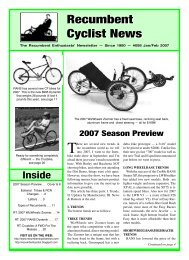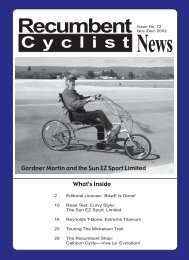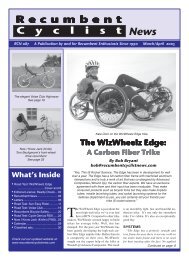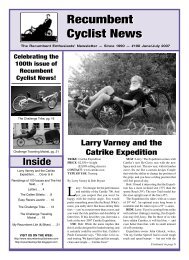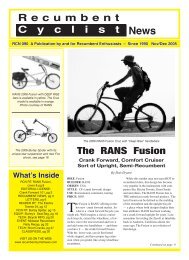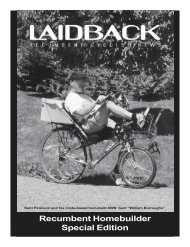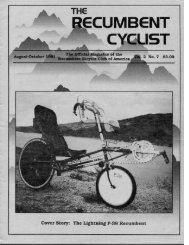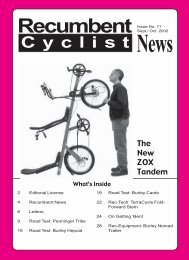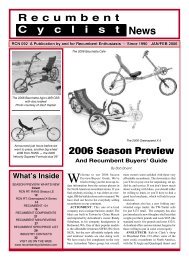In This Issue - Steve Briggs
In This Issue - Steve Briggs
In This Issue - Steve Briggs
Create successful ePaper yourself
Turn your PDF publications into a flip-book with our unique Google optimized e-Paper software.
eader<br />
Review<br />
Wickster SWB &<br />
the Trimuter Trike<br />
by Mike Stern<br />
I’m a recumbent rider from St. Louis, Missouri. Recently I’ve been<br />
searching for a new bike that would outperform what I have. Since I<br />
own a very nice all-around bike, this hasn’t been easy. I rode many.<br />
Unlike uprights, recumbents are manufactured by not just the large<br />
players, like Vision, Easy Riders, BikeE, Lightning, and RANS, but by<br />
many smaller companies like Rotator, Turner, Barcroft, Reynolds,<br />
Optima, just to name a few. Each offers something different. My search<br />
took me to Washington, D.C., <strong>In</strong>diana, Springfield, Illinois, and Chicago.<br />
A trip to the West Coast may be next.<br />
<strong>In</strong> August 2001, on a supported local ride in southern Illinois, my<br />
wife and I stopped for a water break. Mine was the only recumbent<br />
we’ad seen that day (she rides a Bianchi road bike). Then, a blur approached.<br />
It was our second recumbent of the day, but unlike any we<br />
had previously encountered. It was long, sleek, and fast. That is how<br />
we met Jerome Hediger.<br />
Jerome manages Wicks Aircraft Supply in Highland, Illinois, some<br />
40 minutes from St. Louis. Wicks has a long history of distributing<br />
customized components for the aircraft industry. It also manufactures<br />
pipe organs. Jerome is affable, fun to be around, and an avid cyclist<br />
with twelve years of recumbent riding experience. He’s one of the strongest<br />
cyclists I’ve met. Three years ago he convinced the company to<br />
produce the Trimuter, a tadpole trike. <strong>This</strong> year they added a shortwheelbase<br />
recumbent. As our conversation progressed and our interest<br />
grew, my wife and I arranged test rides at the factory. Then, as we<br />
saddled up, we were passed by a group of hard-body wedgie riders.<br />
Jerome decided to give chase. It took him half a mile to catch and pass<br />
them, much to their surprise. I cannot ride like Jerome, but I rode the<br />
bikes he sells.<br />
I’m not technically oriented. For this review I incorporated some of<br />
the technical information Wicks provided and supplemented it with<br />
my own observations. I’m not qualified to explain the ins and outs of<br />
bicycle mechanics, but as a dedicated recumbent rider I know what<br />
feels good to me, what handles right, and what I don’t like. I’ve testridden<br />
a lot of bikes, and I understand that personal preferences differ.<br />
The following are my reviews of the Wicks products.<br />
The Wickster<br />
Wicks offers one SWB model with three component levels. The<br />
Wickster (the test model) has Shimano 105 componentry, the JT Cruiser<br />
has Ultegra parts, and the top-of-the-line HedTurner has Dura-Ace<br />
components. Wicks will build a bike with any componentry mix you<br />
want with a corresponding adjustment in the price.<br />
Frame—All three SWBs share the same frame, a design modified<br />
from the one used by Turner Cycles. Frame tubing is 1.75-inch round<br />
4130 CroMoly. The end cap by the rear triangle is weld capped, not<br />
flattened, for extra strength. All connections are TIG welded. There<br />
are no rough edges. The seatpost is welded to the frame and supported<br />
by welded triangular tubes. The front main tube extends out well beyond<br />
the steering post and houses the boom, which adjusts the pedal<br />
position for rider fit. <strong>This</strong> front portion is cantilevered. Wicks has experimented<br />
with lighter frame materials, but steel is the one material<br />
strong enough to support the boom and the long boom sleeve. The<br />
entire frame is simple in design, solid, and very rigid. I noticed no<br />
bounce in the frame when riding.<br />
Fork—The CroMoly fork has a special forward angle that desensitizes<br />
the steering. <strong>This</strong> results in a tight steering feel with less road<br />
shock transmitted to the hands. The fork has also been widened to<br />
accomodate a disc brake. The angle isn’t extreme, but it results in moving<br />
the front wheel slightly ahead of where it would rest with a more<br />
conventional fork. Welded to the front derallieur post is a metal tab for<br />
mounting the Cateye wireless computer (standard).<br />
Seat—The seat is a formed narrow carbon fiber double shell with<br />
three stiffening vertical ribs. The seat bottom contains two gel pads,<br />
side by side, one to cushion each cheek. Lumbar support is provided<br />
by a tempered foam pad which can be moved up or down to fit the<br />
rider. <strong>This</strong> foam is soft yet supportive and holds its shape. It is similar<br />
to the test pillow found in bedding shops which compresses and slowly<br />
returns to form. The gel pads and foam are then covered with a seatlength<br />
piece of breathable filter foam (similar to what some European<br />
lowriders use to cover their hard-seat shells). All of this is covered<br />
12 Recumbent Cyclist News No. 69<br />
with a breathable mesh seat cover. The result is a seat that is rigid, yet<br />
supportive, and surprisingly comfortable. A built-in feature is a footdeep<br />
pocket in the back of the mesh seat cover for storage of small<br />
items.<br />
The seat attaches to the main frame with allen bolts. The frame contains<br />
threaded nut receptors. The carbon fiber seat has parallel slits in<br />
the bottom and back. Using the allen bolt and washer, one screws the<br />
bolt into the frame nut from the seat side of the slit. Due to the shape of<br />
the seat, the back angle can be adjusted by loosening the bolt and moving<br />
the seat up or down in a pivoting manner. The bolts are then tightened<br />
to hold the seat in place. <strong>This</strong> opens or closes the seat back angle<br />
but does not move the seat back or forward to any degree. When all is<br />
in place, the seat is anchored to the frame with no give.<br />
Water bottle cages attach to the rear of the seat in an upright position<br />
(similar to RANS) as opposed to the parallel position found on Lightning.<br />
There are two cages provided with each bike (again standard).<br />
Handlebar/Stem—Only under-seat steering is available. While adding<br />
an above-seat steering unit is possible, the distance between the<br />
seat front and the steering post would be close, which would make for<br />
cramped quarters for larger riders. The handlebars are a straight T with<br />
no angling of the ends. One grasps the bars by cupping them in your<br />
palms with the back of your hand facing forward. My hands naturally<br />
fell to the bar grips, which were in perfect location for me. Shifting is<br />
done with Dura-Ace bar-end shifters or, if requested, SRAM twist-grip<br />
shifters. I initially tried the bar-end shifters. When these shifters are on<br />
vertical handlebars (as on the trike), they are easy to shift using thumb<br />
and forefinger. However, at the end of a horizontal T-bar you shift with<br />
the pinkie and meat portion of the hand. <strong>This</strong> is similar to the arrangement<br />
found on Lightning’s drop handlebars. It takes some practice, but<br />
after a learning period I adapted and became comfortable with it. Shifting<br />
requires controlling the steering bar with the non- shifting hand<br />
while sliding the shifting hand to the bar end and moving the shifters.<br />
I also tried the twist-grip shifters and found them more to my liking. I



